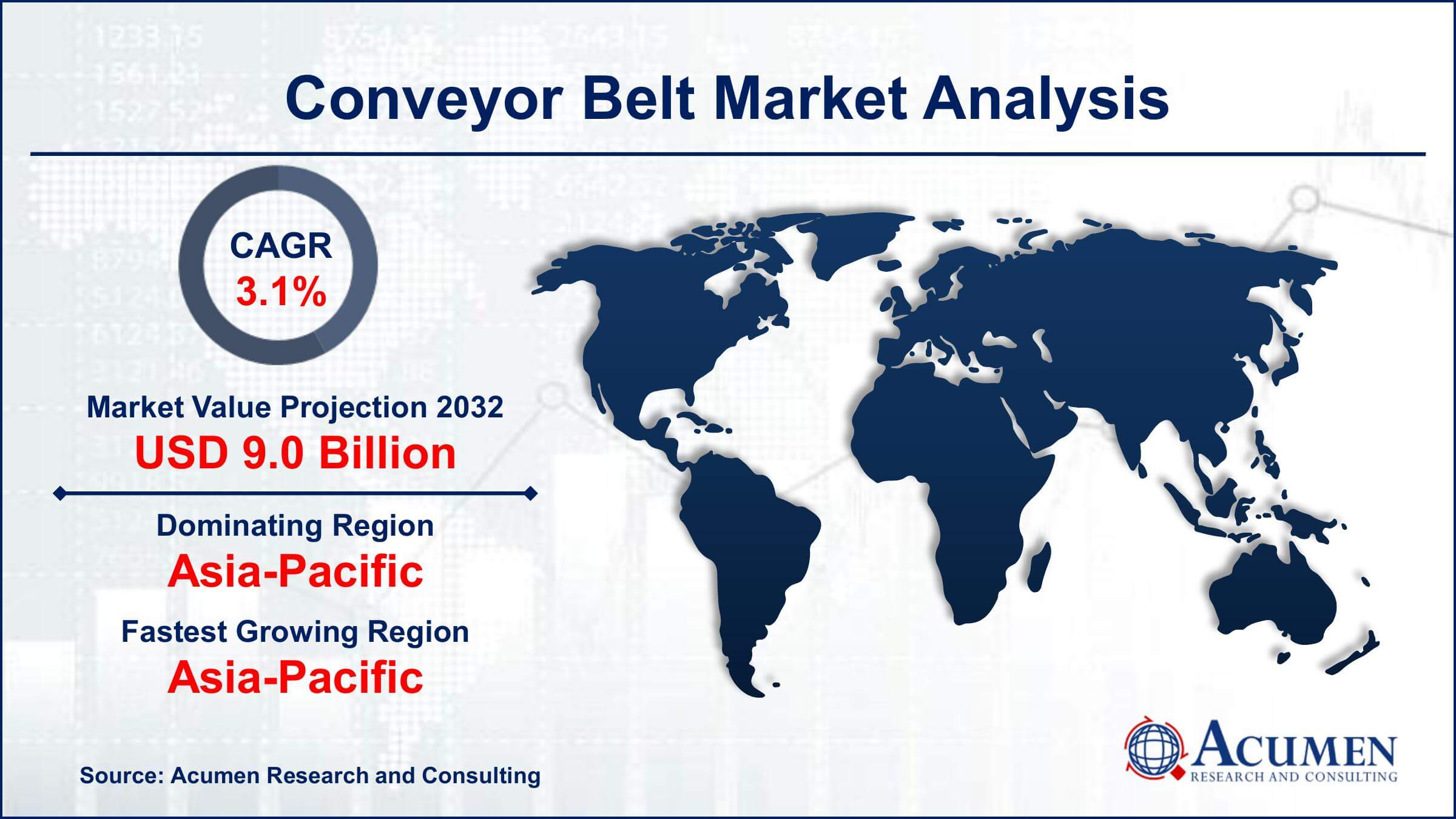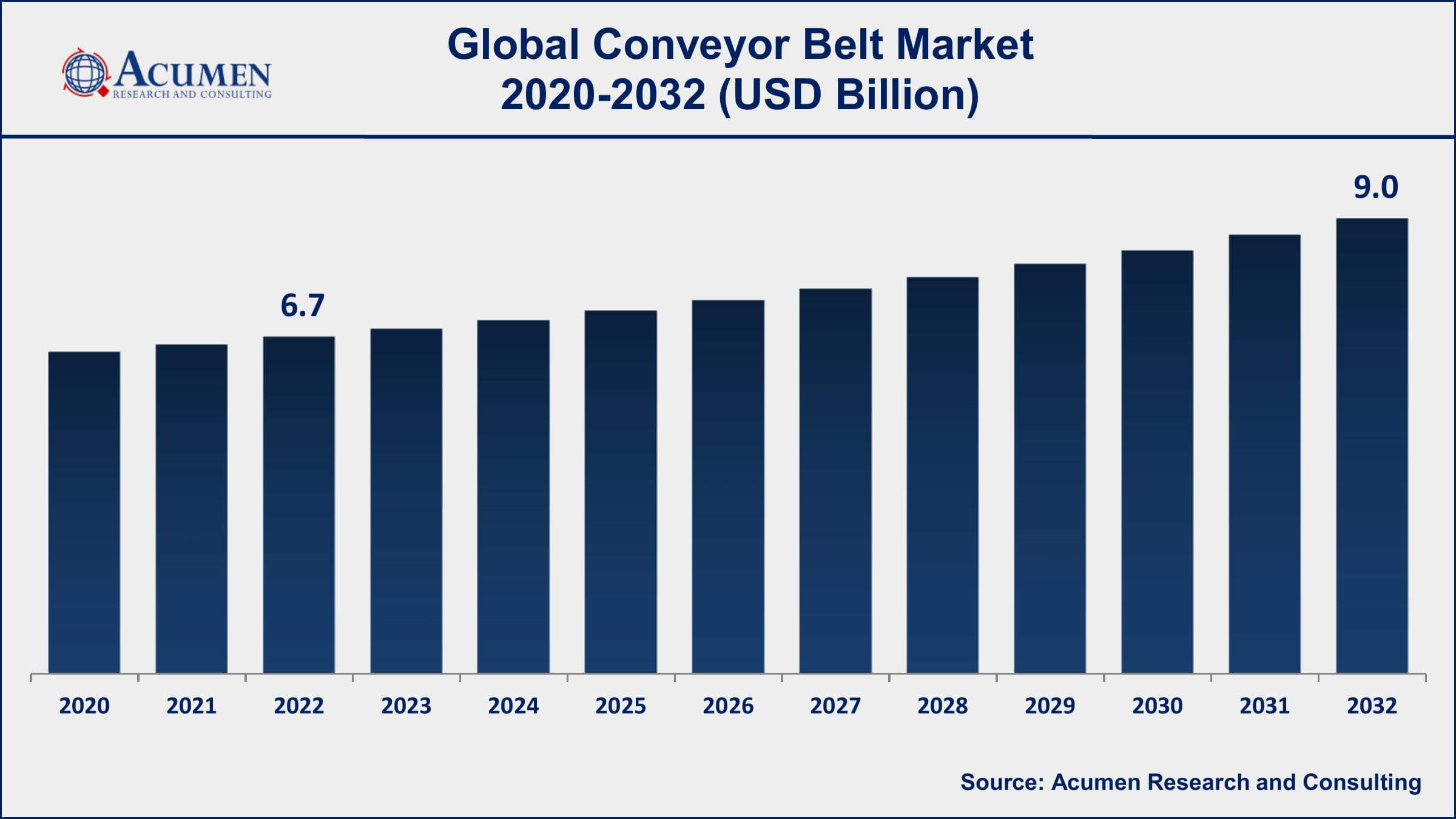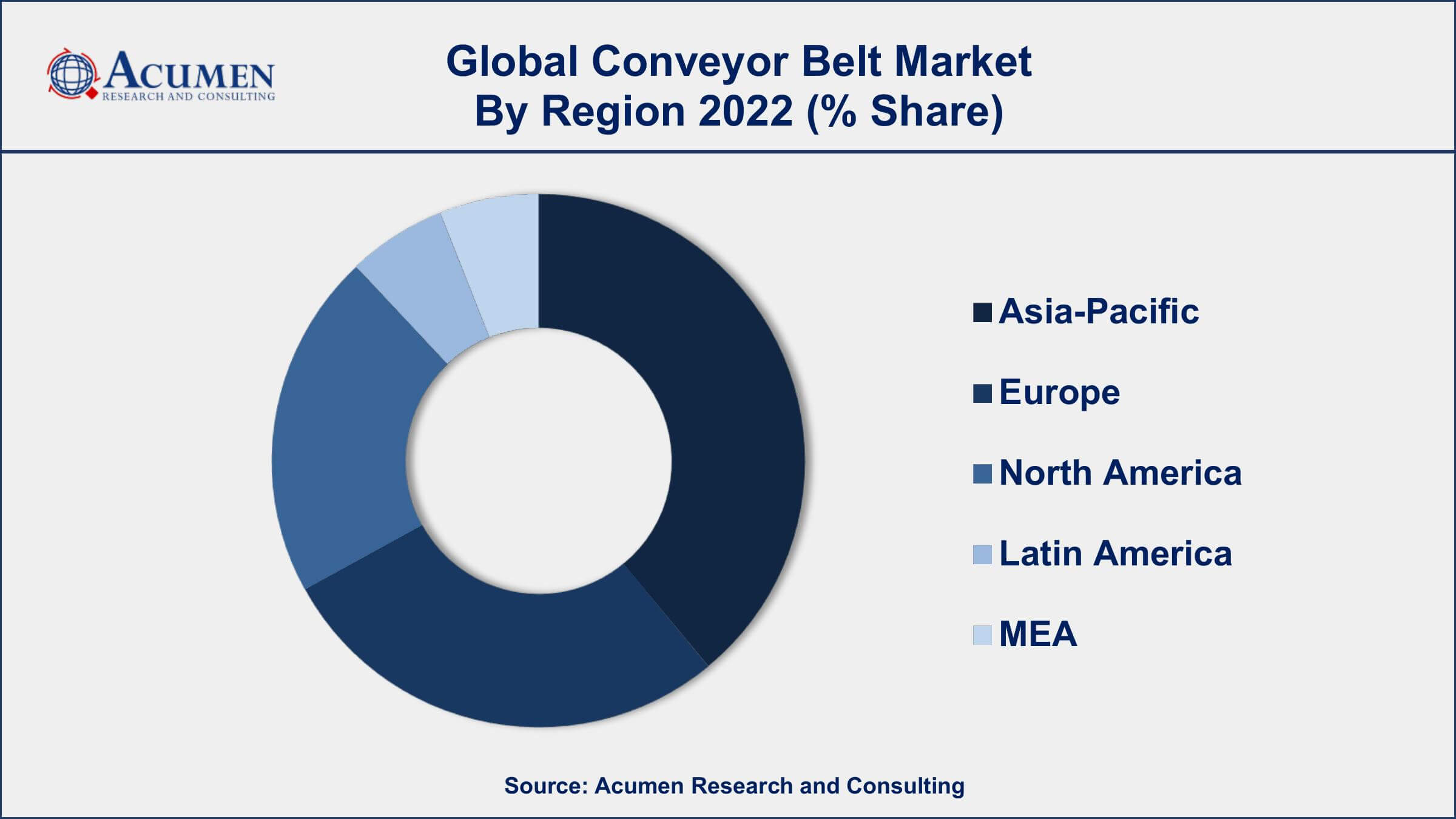Conveyor Belt Market | Acumen Research and Consulting
Conveyor Belt Market Size - Global Industry, Share, Analysis, Trends and Forecast 2023 - 2032
Published :
Report ID:
Pages :
Format :
The Global Conveyor Belt Market Size accounted for USD 6.7 Billion in 2022 and is projected to achieve a market size of USD 9.0 Billion by 2032 growing at a CAGR of 3.1% from 2023 to 2032.
Conveyor Belt Market Highlights
- Global conveyor belt market revenue is expected to increase by USD 9.0 Billion by 2032, with a 3.1% CAGR from 2023 to 2032
- Asia-Pacific region led with more than 54% of conveyor belt market share in 2022
- The medium-weight conveyor belt segment is expected to grow at a CAGR of 4.2% from 2023 to 2032
- The Mining industry is a major end-user of conveyor belts, accounting for a 36% share of the market in 2022
- The general manufacturing segment of the conveyor belt market is expected to grow at a CAGR of 3.2% from 2023 to 2032
- Growing adoption of Industry 4.0 and the Industrial Internet of Things (IIoT) in manufacturing and logistics, drives the conveyor belt market value

A conveyor belt is a mechanical device used to transport materials or goods from one location to another. It is essentially a belt made of various materials, including rubber, fabric, metal, and plastic, that is looped around a series of rollers and driven by a motor. Conveyor belts are commonly used in manufacturing plants, distribution centers, and warehouses to move goods along production lines or from one area to another. They can also be used in mining and other heavy industries to transport large volumes of materials over long distances.
The conveyor belt market has experienced steady growth over the years, driven by the increasing demand for efficient and cost-effective material handling solutions. The market has been positively impacted by advancements in technology, such as the development of automated conveyor systems, which have increased efficiency and reduced labor costs. In addition, rising demand from end-use industries, such as food and beverage, mining, and automotive, has contributed to the growth of the market. The Asia Pacific region is expected to witness significant growth in the conveyor belt industry, owing to the increasing industrialization and urbanization in countries such as China, India, and Japan.

Global Conveyor Belt Market Trends
Market Drivers
- Increasing demand for automated material handling systems in various industries
- Growing demand for conveyor belts in the food and beverage industry to ensure hygiene and safety
- Rising demand for eco-friendly conveyor belts made from recyclable materials
- Increasing use of conveyor belts in the mining industry for transporting bulk materials
Market Restraints
- High installation and maintenance costs associated with conveyor belts
- Risk of equipment failure and downtime, which can result in productivity losses
Market Opportunities
- Growing adoption of Industry 4.0 and the Industrial Internet of Things (IIoT) in manufacturing and logistics
- Increasing demand for lightweight and durable conveyor belts made from advanced materials such as carbon fiber and composite materials
Conveyor Belt Market Report Coverage
| Market | Conveyor Belt Market |
| Conveyor Belt Market Size 2022 | USD 6.7 Billion |
| Conveyor Belt Market Forecast 2032 | USD 9.0 Billion |
| Conveyor Belt Market CAGR During 2023 - 2032 | 3.1% |
| Conveyor Belt Market Analysis Period | 2020 - 2032 |
| Conveyor Belt Market Base Year | 2022 |
| Conveyor Belt Market Forecast Data | 2023 - 2032 |
| Segments Covered | By Material, By Type, By End-user, And By Geography |
| Regional Scope | North America, Europe, Asia Pacific, Latin America, and Middle East & Africa |
| Key Companies Profiled | Continental AG, Bridgestone Corporation, Fenner Dunlop, Bando Chemical Industries, Ltd., Trelleborg AB, Intralox LLC, Habasit AG, Forbo Holdings AG, Ammeraal Beltech, and Yokohama Rubber Company. |
| Report Coverage |
Market Trends, Drivers, Restraints, Competitive Analysis, Player Profiling, Covid-19 Analysis, Regulation Analysis |
Conveyor belts are employed to carry goods and are basically used in manufacturing and mining industries. It comprises two or more pulleys and a belt rotating on them. The pulleys are connected to the motor which helps in rotating the pulleys and eventually the belt. The material to be shifted is placed on the belt and moved to the other end of the belt. The growth in infrastructure activities, for instance, the construction of malls is among the major factors driving the conveyor belt market growth. The rising demand for steel cord conveyor belts is one of the key trends in this industry and is expected to gain huge importance in the coming years. Also, the need for conveyer belts changes depending from application to application and industry to industry. For instance, the coal-mining industry requires high-performance conveyor belt systems like steel cord conveyors to carry heavy loads.
The fast-increasing demand for automation in material handling is one of the major drivers for this market. The increasing need for proficient handling of bulky materials and raw materials further contributes to the rising need for automation in material handling applications. The expansion of industries with several manufacturing facilities such as automotive, retail, and healthcare industries is also demanding the need for automation and conveyor belts in order to facilitate the transportation of large materials.
Conveyor Belt Market Segmentation
The global conveyor belt market segmentation is based on material, type, end-user, and geography.
Conveyor Belt Market By Material
- Metal
- Polymer
- Others
According to the conveyor belt industry analysis, the polymer segment accounted for the largest market share in 2022. This growth is driven by the increasing demand for lightweight and durable conveyor belts made from advanced polymer materials. Polymer-based conveyor belts offer several advantages over traditional conveyor belts made from rubber, fabric, and metal, including increased strength, reduced weight, and improved resistance to wear and tear. Polymer-based conveyor belts are widely used in the food and beverage industry, where hygiene and safety are of utmost importance. These conveyor belts are resistant to bacterial growth, easy to clean, and can withstand extreme temperatures, making them ideal for use in food processing plants and other sanitary environments. The growing demand for eco-friendly conveyor belts made from recyclable materials has also contributed to the growth of the polymer segment.
Conveyor Belt Market By Type
- Medium-Weight Conveyor Belt
- Light-Weight Conveyor Belt
- Heavy-Weight Conveyor Belt
In terms of types, the medium-weight conveyor belt segment is expected to witness significant growth in the coming years. These conveyor belts are typically used in applications that require moderate load-bearing capacity and moderate to high flexibility. The medium-weight conveyor belt segment includes belts made from a range of materials, including rubber, fabric, and plastic. One of the key drivers of growth in the medium-weight conveyor belt segment is the increasing demand for conveyor belts in the packaging industry. Medium-weight conveyor belts are ideal for use in packaging applications, where they can be used to transport materials such as bottles, cans, and cartons. These conveyor belts offer high flexibility and can be customized to meet specific packaging requirements, such as size, shape, and weight.
Conveyor Belt Market By End-user
- Mining
- Food and Beverages
- Power Generation
- Recycling
- Supply Chain
- General Manufacturing
- Others
According to the conveyor belt market forecast, the general manufacturing segment is expected to witness significant growth in the coming years. Conveyor belts are widely used in general manufacturing applications, such as assembly lines, material handling, and packaging, to improve efficiency, reduce labor costs, and increase productivity. Conveyor belts are also used in general manufacturing to transport a wide range of materials, including raw materials, finished products, and waste materials. The growing demand for conveyor belts in the general manufacturing segment is driven by several factors, including the increasing use of automation and robotics in manufacturing, the need to reduce labor costs, and the growing demand for eco-friendly and energy-efficient manufacturing processes. Conveyor belts are an essential component of automated material handling systems and are widely used in manufacturing plants to transport materials between machines and workstations.
Conveyor Belt Market Regional Outlook
North America
- U.S.
- Canada
Europe
- U.K.
- Germany
- France
- Spain
- Rest of Europe
Asia-Pacific
- India
- Japan
- China
- Australia
- South Korea
- Rest of Asia-Pacific
Latin America
- Brazil
- Mexico
- Rest of Latin America
The Middle East & Africa
- South Africa
- GCC Countries
- Rest of the Middle East & Africa (ME&A)

Conveyor Belt Market Regional Analysis
The Asia-Pacific region dominates the conveyor belt market, accounting for a significant share of the overall market. There are several factors that contribute to the region's dominance, including the growing industrialization and urbanization in the region, the increasing demand for automation and material handling equipment, and the presence of a large manufacturing base. One of the key factors driving the growth of the Asia-Pacific region is the increasing demand for automation and material handling equipment in manufacturing, logistics, and transportation industries. Conveyor belts are an essential component of automated material handling systems, and as the demand for automation increases in the region, the demand for conveyor belts is also expected to increase. Moreover, the Asia-Pacific region has a large manufacturing base, with countries such as China, Japan, and India being major contributors to the market growth.
Conveyor Belt Market Player
Some of the top conveyor belt market companies offered in the professional report include Continental AG, Bridgestone Corporation, Fenner Dunlop, Bando Chemical Industries, Ltd., Trelleborg AB, Intralox LLC, Habasit AG, Forbo Holdings AG, Ammeraal Beltech, and Yokohama Rubber Company.
Frequently Asked Questions
What was the market size of the global conveyor belt in 2022?
The market size of conveyor belt was USD 6.7 Billion in 2022.
What is the CAGR of the global conveyor belt market from 2023 to 2032?
The CAGR of Conveyor Belt is 3.1% during the analysis period of 2023 to 2032.
Which are the key players in the conveyor belt market?
The key players operating in the global market are including Continental AG, Bridgestone Corporation, Fenner Dunlop, Bando Chemical Industries, Ltd., Trelleborg AB, Intralox LLC, Habasit AG, Forbo Holdings AG, Ammeraal Beltech, and Yokohama Rubber Company.
Which region dominated the global conveyor belt market share?
Asia-Pacific held the dominating position in conveyor belt industry during the analysis period of 2023 to 2032.
Which region registered fastest CAGR from 2023 to 2032?
Asia-Pacific region exhibited fastest growing CAGR for market of conveyor belt during the analysis period of 2023 to 2032.
What are the current trends and dynamics in the global conveyor belt industry?
The current trends and dynamics in the conveyor belt industry include increasing demand for automated material handling systems in various industries, growing demand for conveyor belts in the food and beverage industry to ensure hygiene and safety, and rising demand for eco-friendly conveyor belts made from recyclable materials.
Which type held the maximum share in 2022?
The medium-weight conveyor belt type held the maximum share of the conveyor belt industry.



